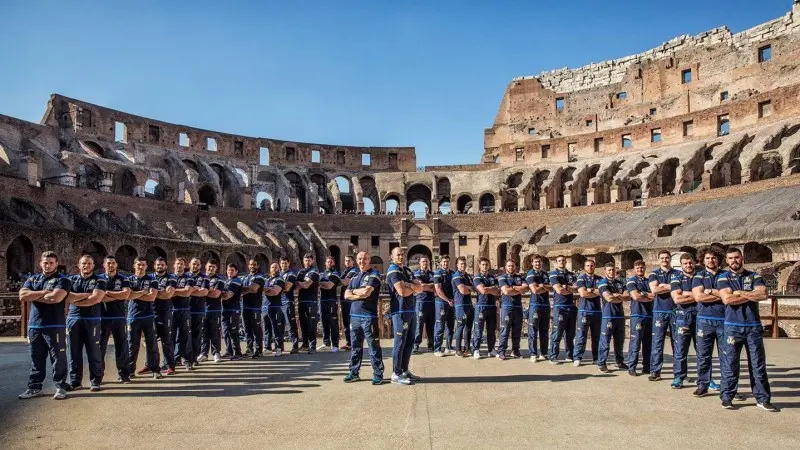The Six Nations provides Europe’s best with an annual opportunity to renew rivalries and friendships in six appealing yet contrasting host cities.
In a new series, take a look at what makes each of them so special, find out what the main attractions are and get some top tips about away day trips on match day.
We kick it off in Rome, the Eternal City and the location of the Stadio Olimpico, the venue for Italy’s home games in Rugby’s Greatest Championship. Main attractions Hundreds of books have been written about what to do in Rome, so consider this list far from exhaustive, but for those visiting the Italian capital for the first time, there are a few must-see sights.
First and foremost, we start with the Colosseum, the spectacular amphitheatre that serves as the precursor to modern sports stadia.
The largest structure that remains from Roman antiquity, the Colosseum is synonymous with Rome and its gladiatorial history.
After the Colosseum we switch countries to the Vatican City and all the delights that come with the world’s smallest state.
The Sistine Chapel ceiling, Michelangelo’s masterpiece, and St Peter’s Basilica are the best-known sights but there are also works from the likes of Bernini, Botticelli and Raphael to admire.
Between the Colosseum and the Vatican is another of Rome’s most famous attractions, the Pantheon. This church, built on a former temple, is iconic thanks to its Corinthian columns while inside it features a rotunda under concrete dome with an oculus that opens to the sky.
For rugby fans trying to fit everything into a Six Nations weekend, that is already a fairly busy weekend. However not far from the Pantheon it is worth heading to the Trevi Fountain, arguably the world’s most famous fountain, while the Spanish Steps and Piazza Navona are also within walking distance. Transport advice There is no shortage of options on arrival by plane from Fiumicino airport, whether you want to take a taxi or a bus into the centre of town.
From there perhaps the best value travel option is the Roma Pass which combines free public transport for three days with entry into two museums or archaeological sites and concessionary tickets thereafter.
If that is more than is required, public transport is fairly straightforward and relatively inexpensive. How to get to the ground? As well as the numerous taxis, there are both trams and buses that can take supporters to the Stadio Olimpico, in the north west of the city.
Line 2 on the tram stops at Mancini, just across the river from the ground, while the 32 bus and the 280 bus also stop near the ground. It is also easily accessible by car for those who are driving. Top tips Using simple phrases like ciao (hello), per favore (please) grazie (thank you) and prego (you’re welcome) will always go down well.
For the more ambitious supporters ‘Sergio Parisse è il mio giocatore preferito’ (Sergio Parisse is my favourite player) should also win over a few friends at the ground.
When visiting the city, it’s important to remember that Italians tend to eat their evening meals a little later than in some countries, so prepare to dine after 8.30pm.
Finally for sightseeing be careful on Mondays, which is a rest day in Italy when most of the museums will be closed. By contrast, on the first Sunday of each month, many of the museums and archaeological sites are free to the public so in those years that Italy play at home on the first weekend of February and March, there is an extra incentive to book that trip to Rome. 2019 fixtures The 2019 Six Nations will see Italy play three games at home, in rounds two, three and five.
In the first of those encounters the Azzurri will play host to Wales before defending champions Ireland head to Rome a fortnight later.
Then on Super Saturday, Conor O’Shea’s side will entertain France in the battle for the Garibaldi Trophy on the final weekend. Three standout matches Between the Stadio Olimpico and the Stadio Flaminio, Rome has hosted matches for 18 years now, with a number of historic moments over that time.
The first of those was going to be memorable, regardless of the result, but as it turned out, it was also a brilliant performance from the Azzurri.
Hosting Scotland, Diego Dominguez pulled the strings scoring 29 points including three drop goals in a 34-20 success that well and truly announced Italy’s arrival in the Championship.
Eight years later, the Scots were back in Rome with Italy searching for a win to finish the campaign having fallen just short against both Ireland and England.
In one of the most dramatic finishes in the Championship’s history Andrea Marcato and Chris Paterson exchanged late penalties to leave the scores at 20-20 with eight minutes remaining.
As time ticked down, Italy worked their way into the Scottish 22 and with 40 seconds left the ball was flung back to Marcato who calmly stroked over the drop goal to seal a famous victory.
Fast-forward five years and it was France who came to town, looking to make up for their first loss to the Azzurri in the Championship two years earlier.
Jacques Brunel’s men had very different ideas though, scoring a delightful early try through Sergio Parisse, and another from Martin Castrogiovanni on the hour to see off their closest rivals 23-18 on their way to a fourth-placed finish in the Championship.



